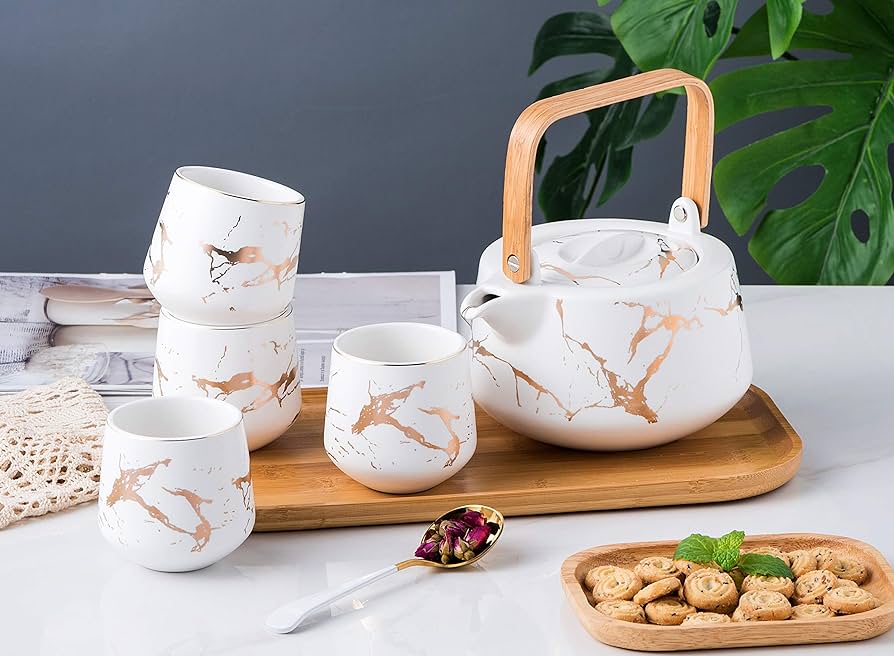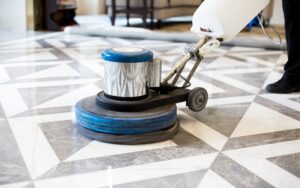The Exquisite World Of Teapot Sets: A Comprehensive Guide For Tea Enthusiasts

Key Take a ways:
- Teapot sets have a rich history and have evolved over time in different cultures.
- Teapot sets hold symbolism and cultural significance in China, Japan, and Britain.
- Ceramic teapot sets are durable, versatile, and retain heat well.
- Glass teapot sets are visually appealing and allow for the appreciation of the brewing process.
- Cast iron teapot sets are known for their durability, heat retention, and enhanced flavor.
- When choosing a teapot set, consider the size, design, and functional features.
- Proper care and maintenance are important for preserving the beauty and functionality of teapot sets.
- Cleaning techniques vary depending on the material of the teapot set.
- Store teapot sets in a safe location to prevent damage and breakage.
- Minor repairs can be done for ceramic and glass teapots, while professional assistance is recommended for restoring cast iron teapots.
The History and Evolution of Teapot Sets
Teapot sets have a rich history that spans centuries, originating from different parts of the world. The sipping of tea, a practice that has become ingrained in various cultures, dates back to ancient times. The concept of brewing tea leaves in a pot and serving it in a beautifully crafted vessel has evolved over time, with each era and culture leaving its unique mark.
The Ancient Origins of Teapot Sets
The first appearance of teapot sets can be traced back to the Tang Dynasty in China, around the 9th century. These early teapots were made of earthenware and were characterized by a simple design, with a handle and spout for pouring. The evolution of teapot sets continued during the Song Dynasty, where the use of loose tea leaves gained popularity. This led to the development of more intricate teapot designs.
As tea drinking spread across continents, teapot sets started to emerge in other cultures. In Japan, the art of tea ceremony, known as chanoyu, influenced the design and aesthetic of teapots. These Japanese teapots, known as kyusu, often featured a side handle and a built-in strainer to catch tea leaves.
Innovations and Influences in Teapot Design
Throughout history, teapot sets have been influenced by various factors, including cultural exchange, technological advancements, and artistic movements. The introduction of porcelain in China during the Yuan Dynasty allowed for more delicate and intricate designs. The Ming Dynasty further refined teapot craftsmanship, with skilled artisans creating teapots adorned with intricate patterns and motifs.
During the industrial revolution in Europe, the invention of the tea infusion method led to the mass production of teapots. This made teapot sets more accessible to a wider audience. The Victorian era in England brought about a fascination with detailed teapot designs, often depicting natural elements and scenes from everyday life.
The Symbolism and Cultural Significance of Teapot Sets
Teapot sets hold great symbolism and cultural significance in various parts of the world. In China, the teapot is seen as a symbol of hospitality and is often used during important social gatherings. In Japan, teapot sets are closely associated with the tea ceremony, a ritualistic practice that emphasizes zen, tranquility, and respect.
Teapot sets also hold cultural significance in countries like Britain, where tea drinking is deeply ingrained in society. The use of teapots and the act of pouring tea symbolize hospitality, warmth, and the art of conversation. Even in contemporary culture, teapots continue to evoke a sense of tradition and elegance.
Exploring Different Types and Materials of Teapot Sets
Teapot sets come in a variety of types and materials, each with its own unique characteristics and aesthetic appeal. Whether you prefer a classic ceramic teapot, a modern glass teapot, or a traditional cast iron teapot, there is a teapot set to suit every taste.
Ceramic Teapot Sets: A Classic Choice
Ceramic teapot sets have long been a popular choice due to their durability, versatility, and aesthetic appeal. They come in a range of designs, from simple and minimalist to intricately hand-painted. Ceramic teapots retain heat well and are suitable for brewing various types of tea. Additionally, they are easy to clean and maintain.
One popular type of ceramic teapot is the Yixing teapot from China. Made from purple clay, these teapots are highly regarded for their ability to enhance the flavor of tea over time. The porous nature of the clay allows the teapot to absorb and retain the flavors of different teas, resulting in a more enjoyable tea-drinking experience.
Glass Teapot Sets: Beauty and Practicality in One
Glass teapot sets have gained popularity in recent years for their modern and elegant aesthetic. The transparency of glass allows tea enthusiasts to visually appreciate the brewing process, witnessing the leaves unfurl and infuse the water with their flavors. Glass teapots are also easy to clean and are suitable for a variety of teas.
One notable variation of glass teapot sets is the double-walled glass teapot. This innovative design provides insulation, keeping the tea hot for longer without overheating the exterior of the teapot. The double-walled construction also adds a layer of durability, making it less prone to breakage.
Cast Iron Teapot Sets: Strength, Durability, and Tradition
Cast iron teapot sets have a long-standing tradition in Japan and are known for their durability and heat retention properties. These teapots often feature intricate designs, reflecting Japanese art and culture. Cast iron teapots distribute heat evenly, ensuring a consistent brew, and can keep the tea warm for an extended period.
Another advantage of cast iron teapot sets is their ability to enhance the taste of tea. The iron interacts with the tannins in the tea, reducing bitterness and creating a smoother, more balanced flavor profile. Cast iron teapots require proper care to prevent rusting, but with regular maintenance, they can last for generations.
Tips for Choosing the Perfect Teapot Set
When selecting a teapot set, there are several factors to consider to ensure it meets your brewing preferences and aesthetic preferences. Finding the perfect teapot involves assessing size, design, and functional features.
Finding the Right Size for Your Tea Brewing Needs
The size of your teapot should align with your tea brewing habits. If you typically brew tea for one or two people, a smaller teapot will suffice. However, if you enjoy hosting tea parties or brewing larger quantities, a larger teapot may be more suitable. It’s important to strike a balance between having enough capacity and ensuring the teapot is easy to handle and pour.
Considering the Aesthetic Appeal and Design Elements
The design and aesthetic appeal of a teapot set can enhance your tea-drinking experience. Whether you prefer a minimalist, modern design or a teapot adorned with intricate patterns and motifs, there is a style to match every taste. Consider the overall look and feel of your teapot set, as it can add a touch of elegance and beauty to your tea rituals.
Exploring Functional Features and Extras
Some teapot sets come with additional features and accessories that can enhance the brewing process. For example, a built-in tea infuser or strainer can make it easier to brew loose tea leaves without the need for additional tools. Other teapot sets may include matching tea cups, providing a cohesive and visually appealing tea-drinking experience.
Care and Maintenance of Teapot Sets: Preserving Their Beauty and Functionality
Proper care and maintenance are essential for preserving the beauty and functionality of your teapot sets. The specific cleaning and storage methods will depend on the material of the teapot.
Proper Cleaning Techniques for Different Teapot Materials
Ceramic teapot sets can usually be cleaned with warm water and mild soap. It’s important to avoid abrasive materials that can scratch the surface. Glass teapot sets can be washed in a similar manner, but care must be taken to prevent accidental breakage. Cast iron teapot sets require a different cleaning approach. After each use, they should be rinsed with hot water and wiped dry to prevent rusting. Avoid using soap or scrub brushes that could damage the seasoning on the teapot’s interior.
Storage Tips to Prevent Damage and Breakage
When storing teapot sets, it’s important to find a safe and secure place to prevent damage and breakage. Ceramic and glass teapot sets should be stored in a cabinet or shelf away from potential hazards. It’s also advisable to wrap them in a soft cloth or protective bag to minimize the risk of scratches or accidental knocks. Cast iron teapot sets should be stored in a dry location to prevent rusting.
Repairing and Restoring Teapot Sets: DIY or Professional Assistance?
In the event of damage or wear over time, teapot sets may require repair or restoration. Minor chips or cracks in ceramic or glass teapots can often be repaired using specialized adhesives designed for such materials. However, for more extensive repairs or restoring cast iron teapots, it’s generally best to seek professional assistance. Skilled artisans and restoration experts have the knowledge and tools to ensure the teapot is repaired or restored without further damage.
FAQ
Question: What is the origin of teapot sets? – Teapot sets have a rich history that originated in different parts of the world, with the earliest appearances traced back to the Tang Dynasty in China around the 9th century. They have since evolved and been influenced by various cultures and eras.
Question: What are the different types of teapot sets? – Teapot sets come in various types and materials, including ceramic, glass, and cast iron. Each type offers unique characteristics and aesthetic appeal, catering to different preferences and brewing needs.
Question: How do ceramic teapot sets differ from other types? – Ceramic teapot sets are known for their durability, versatility, and aesthetic appeal. They retain heat well and are suitable for brewing different types of tea. Ceramic teapots also come in various designs, from minimalist to intricately hand-painted.
Question: What makes glass teapot sets popular? – Glass teapot sets have gained popularity due to their modern and elegant aesthetic. The transparency of glass allows for the visual appreciation of the brewing process. Glass teapots are easy to clean and suitable for different types of tea.
Question: What are the advantages of cast iron teapot sets? – Cast iron teapot sets are known for their durability, heat retention, and ability to enhance the taste of tea. They often feature intricate designs reflecting Japanese art and culture. Proper care is required to prevent rusting.
Question: How do you choose the right teapot set? – When selecting a teapot set, consider factors such as size, design, and functional features. The size should align with your brewing needs, the design should be aesthetically appealing, and additional features such as built-in infusers can enhance the brewing process.
Question: How should teapot sets be cleaned? – The cleaning technique for teapot sets depends on the material. Ceramic and glass teapots can usually be cleaned with warm water and mild soap, while cast iron teapots should be rinsed with hot water and wiped dry to prevent rusting.
Question: What should be done if a teapot set is damaged? – Minor chips or cracks in ceramic or glass teapots can often be repaired using specialized adhesives. However, for more extensive repairs or restoring cast iron teapots, seeking professional assistance from skilled artisans or restoration experts is usually recommended.








